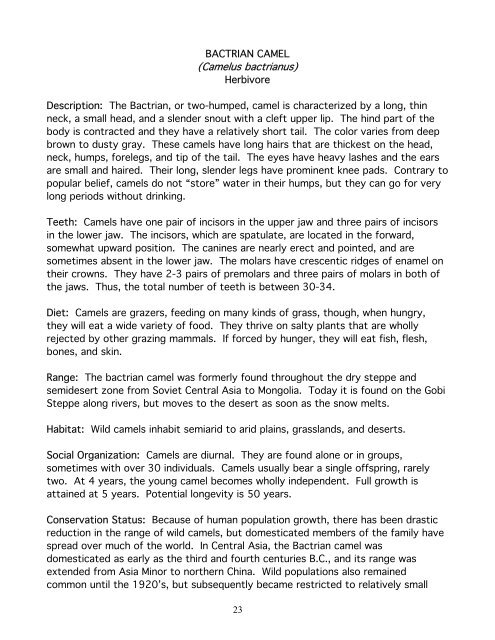TABLE OF CONTENTS - National Zoo
TABLE OF CONTENTS - National Zoo
TABLE OF CONTENTS - National Zoo
You also want an ePaper? Increase the reach of your titles
YUMPU automatically turns print PDFs into web optimized ePapers that Google loves.
BACTRIAN CAMEL<br />
(Camelus bactrianus)<br />
Herbivore<br />
Description: The Bactrian, or two-humped, camel is characterized by a long, thin<br />
neck, a small head, and a slender snout with a cleft upper lip. The hind part of the<br />
body is contracted and they have a relatively short tail. The color varies from deep<br />
brown to dusty gray. These camels have long hairs that are thickest on the head,<br />
neck, humps, forelegs, and tip of the tail. The eyes have heavy lashes and the ears<br />
are small and haired. Their long, slender legs have prominent knee pads. Contrary to<br />
popular belief, camels do not “store” water in their humps, but they can go for very<br />
long periods without drinking.<br />
Teeth: Camels have one pair of incisors in the upper jaw and three pairs of incisors<br />
in the lower jaw. The incisors, which are spatulate, are located in the forward,<br />
somewhat upward position. The canines are nearly erect and pointed, and are<br />
sometimes absent in the lower jaw. The molars have crescentic ridges of enamel on<br />
their crowns. They have 2-3 pairs of premolars and three pairs of molars in both of<br />
the jaws. Thus, the total number of teeth is between 30-34.<br />
Diet: Camels are grazers, feeding on many kinds of grass, though, when hungry,<br />
they will eat a wide variety of food. They thrive on salty plants that are wholly<br />
rejected by other grazing mammals. If forced by hunger, they will eat fish, flesh,<br />
bones, and skin.<br />
Range: The bactrian camel was formerly found throughout the dry steppe and<br />
semidesert zone from Soviet Central Asia to Mongolia. Today it is found on the Gobi<br />
Steppe along rivers, but moves to the desert as soon as the snow melts.<br />
Habitat: Wild camels inhabit semiarid to arid plains, grasslands, and deserts.<br />
Social Organization: Camels are diurnal. They are found alone or in groups,<br />
sometimes with over 30 individuals. Camels usually bear a single offspring, rarely<br />
two. At 4 years, the young camel becomes wholly independent. Full growth is<br />
attained at 5 years. Potential longevity is 50 years.<br />
Conservation Status: Because of human population growth, there has been drastic<br />
reduction in the range of wild camels, but domesticated members of the family have<br />
spread over much of the world. In Central Asia, the Bactrian camel was<br />
domesticated as early as the third and fourth centuries B.C., and its range was<br />
extended from Asia Minor to northern China. Wild populations also remained<br />
common until the 1920’s, but subsequently became restricted to relatively small<br />
23
















